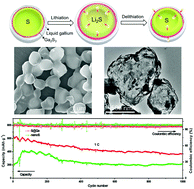A liquid metal-based self-adaptive sulfur–gallium composite for long-cycling lithium–sulfur batteries†
Abstract
Lithium–sulfur (Li–S) batteries have been regarded as a promising candidate for energy storage owing to their ultrahigh theoretical capacity and low cost. However, the commercial application of Li–S batteries has been plagued by the huge volume change of sulfur, the insulative nature of solid active materials (S and Li2S) and the polysulfide shuttle. Here, a uniform sulfur–gallium core–shell structure (S@Ga) with an ultrathin liquid gallium shell was prepared by harnessing the reaction between sulfur and gallium via a facile mixing process. In this S@Ga composite, the thin gallium shell not only exhibits the self-adaptive characteristic to perfectly adapt to the varying volume change of sulfur, restraining the polysulfide shuttle, but also acts as a conductive agent to enhance the electronic/ion transmission, improving the rate capacity of the S@Ga cathode. Therefore, the resultant S@Ga cathode exhibits a high capacity of 1295 mA h g−1 at 0.1C and a high cycling stability with a small decay of 0.043% per cycle for 1000 cycles at 1C.



 Please wait while we load your content...
Please wait while we load your content...